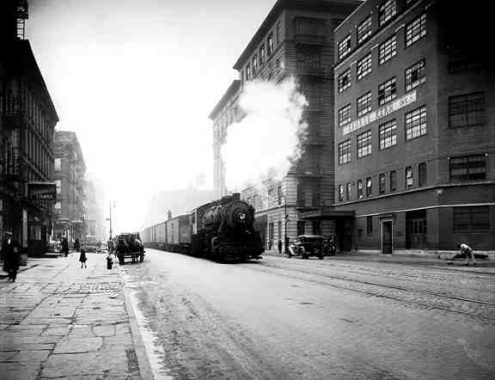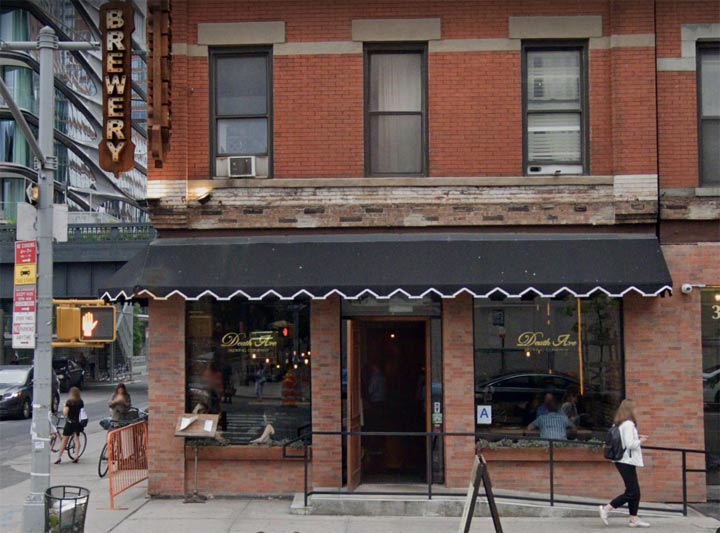A tavern serving Greek-American delicacies called Death Avenue has held down the northwest corner of 10th Avenue and West 28th Street since 2017. This seems like a fatalistic name for a drinking establishment. The name has nothing to do with the coronavirus, speeding traffic, or any other recent phenomena. Rather, it evokes Chelsea’s dim past in which steam railroad engines pulling freight cars traveled up and down 10th Avenue and, unfortunately, accounted for not a few fatalities when they struck pedestrians and horses pulling carts.

The Hudson River Railroad was established in 1851 and while it ran along the Hudson River north of NYC, it ran along West Street and 10th Avenue as far north as West 30th Street, whereupon it ran along a right of way northwest to 11th Avenue and traveled north to West 60th; only then did it swerve west toward the river.
The steam engine was often preceded by a man on horseback, who blew a horn and did the best he could do warn everyone the train was coming. By 1869, the line was merged by rail magnate Cornelius Vanderbilt to create the New York Central and Hudson River Railroad. A large freight depot was constructed at the line’s southern end at Washington and West Houston Streets; all passenger service on the line ended pretty early on in 1871.
By the early 20th Century Manhattan’s west side was getting built out and was a great deal more congested, and the freights began to be a problem as more and more incidents, injuries and deaths were occurring, so much so that 10th and 11th Avenues were both known as “Death Avenue.” This was the spur that led to the construction of the West Side Freight Elevated line in 1934, which ran on its own elevated right of way. That road served freight train in lower Manhattan until 1980; it then lay moribund until it was reimagined as an elevated park now known as the High Line. The NYC & HRR plied 10th and 11th Avenues until 1941.
In the photo, you can see the elevated High Line at the left. To its rear is one of the more fanciful-looking of the new high rise apartment buildings that have sprung up in the area following the High Line’s gradual opening between 2009-2014.
To its credit the tavern devotes an entire webpage to its name and its inspiration.
High Line Before the Hoopla, 1999
Back on the High Line Again, 2009
High Line from 20th-30th Streets
The High Line Section That Won’t Be a Park
Check out the ForgottenBook, take a look at the gift shop, and as always, “comment…as you see fit.”
3/9/20


4 comments
Interesting history. The Death Avenue moniker was partly a protest against large corporations subverting the democratic process where human life was at stake.. Nothing like today.
WTF?! Too much COVID-19 self quarantine can be a bad thing.
So “Death Avenue” follows “Corona Fever”…LOL!!!
A few factoids:
The men on horseback who traveled just ahead of the trains were called “Death Avenue Cowboys.”
The LIRR storage yard at West 33rd and 10th Avenue was originally a large freight yard for the NY Central RR. At one time, much of the food consumed in NYC was delivered on this rail line; the site of today’s LIRR yard was called 30th Street Yard. Much of the food delivered along this line was transferred to trucks or wagons there, for final deliveries.
North of today’s LIRR yard, the tracks originally along 11th Avenue were placed in an open cut between 10th and 11th Avenues, which is still in use by Amtrak trains operating between Penn Station and Upstate New York and Canadian points.